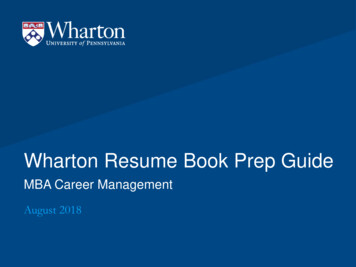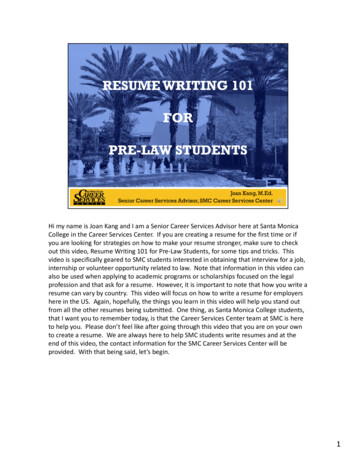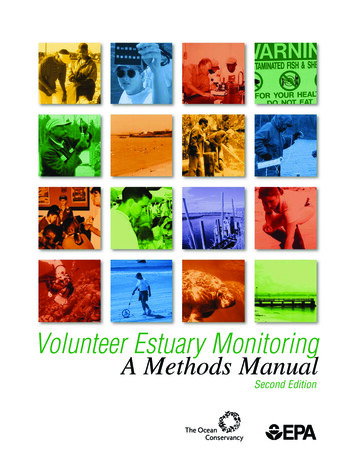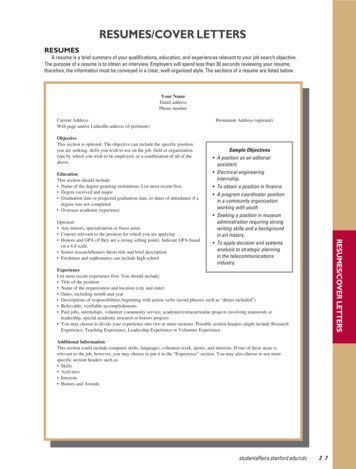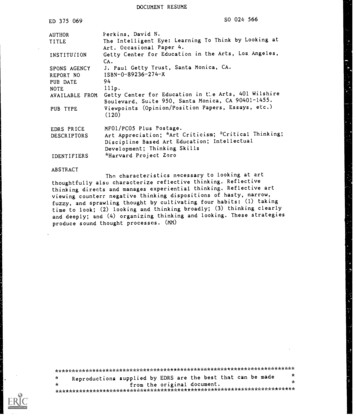
Transcription
DOCUMENT RESUMESO 024 566ED 375 069AUTHORTITLEINSTITUTIONPerkins, David N.The Intelligent Eye: Learning To Think by Looking atArt. Occasional Paper 4.Getty Center for Education in the Arts, Los. Angeles,CA.J. Paul Getty Trust, Santa Monica, CA.ISBN-0-89236-274-XSPONS AGENCYREPORT NOPUB DATENOTEAVAILABLE FROM94111p.Getty Center for Education in t'.e Arts, 401 WilshirePUB TYPEBoulevard, Suite 950, Santa Monica, CA 90401-1455.Viewpoints (Opinion/Position Papers, Essays, etc.)(120)EDRS PRICEDESCRIPTORSIDENTIFIERSMFO1 /PCO5 Plus Postage.Art Appreciation; *Art Criticism; *Critical Thinking;Discipline Based Art Education; IntellectualDevelopment; Thinking Skills*Harvard Project ZeroABSTRACTThn characteristics necessary to looking at artthoughtfully also characterize reflective thinking. Reflectivethinking directs and manages experiential thinking. Reflective artviewing counters negative thinking dispositions of hasty, narrow,fuzzy, and sprawling thought by cultivating four habits: (1) takingtime to look; (2) looking and thinking broadly; (3) thinking clearlyand deeply; and (4) organizing thinking and looking. These strategiesproduce sound thought processes. *************************Reproductions supplied by EDRS are the best that can be madefrom the original ******************************
L.UDEPARTMENT OF EDUCATION011icrt ot Edocatroio1Ramerth and ImprompitintEDUCATIONAL RESOURCES INFORMATIONCENTER (ERIC)TM, document has boon rorrody Ad asrecrniad from the pinion or orSamiihonorigtnatmo ItMinor changes nava boon made to improverproduclion QualityPants& reow or opinions statird in the doe trmint do not necosaarity represnt orticalOE RI pottrloon or policy"PERMISSION TO REPRODUCE THISMATERIAL HAS BEEN GRANTED BYoc,e A\DTO THE EDUCATIONAL RESOURCESINFORMATION CENTER (ERIC)"41--tBEST COPY AVAILABLE
TheIntelligentEye3Learningto Thinkby Lookingat Art
The Getty Center for Education in the ArtsOccasional Paper SeriesThe Bole of Imagery. in LearningIlarry S. BroudyThoughts on Art EducationRudolf' Arnheiiii.-1rt Education and Human DevelopmentHoward GardnerThe Intelligent Eye: Learning to Think by Looking at .-111David N. Perkins
TheLearningto Thinkby LookingIntelligentEyat ArtDAVID N. PERKINSHarvard Project ZeroHarvard Graduate School of EducationOccasional Paper 4The Getty Centerfor Education in the ArtsZl
1994. The J. Paul Getty Trust. All rights reserved.Printed in the United States of America.The Getty Center far Education in the ArtsSanta Monica. CaliforniaI.ihrary of Congress Cataloging-in-Publication DataPet ktns. Da id N.The intelligent eye : learning to think by looking at art / DavidN. Perkins.p.cm.(Occasional papers : 4)Includes bibliographical references.ISBN 0- 89256 274 -\t. Visual perception. 2. Art appreciation.I. Title.3. Critical thinking.II. Series: Occasional paper (Getty Center for Educationin the Arts) :4.N7450.5-1'52199-4701'.1dc2o94-30CIPExcerpt on p. 30 from -The ilolloN% Alen." in Co/ice/co' Poems 1909-1962 by T. S.Eliot, copyright 1936 by Ilarcourt Brace & Company, copyright 1964, 1963 byT. S. Eliot. reprinted by permission of the publisher."Musi,e des Beaux \ rts." p. i9. from Collected Poems by W. II. laden. Copyright 1940 and renewed 1968 by NN .Ii. kuden. Reprinted by permission of RandomIloose. Inc.
Table of ContentsList of IllustrationsviForeword by Mary Ann StankiewiczixAcknowledgmentsxivArt and the Art of Intelligence2 The Intelligent Eye73 The Challenge of the Invisible174 Knowledge Gaps and Intelligence Traps255Giving Looking Time366Making Looking Broad and Adventurous477Making Looking Clear and Deep598Making Looking Organized709Building the Mind through Art82ReferencesBiography95
List of IllustrationsNote: All works chosen are monochrome in the original and usually black and white to ensure thatthe black and white photographs used here represent them well.1.Prow board of a Tanimbarese sailing boat, date unknown. Carved wood, 5 1/2 ft. high.The Barbier-Mueller Mi 'sewn, Geneva, Switzerland. Photograph: P. A. Ferrazzini2.2Paul Rleelliidchen unter der Sonne (Girl Beneath the Sun), 1929. Pen and ink, 12 x 6 in.0 1993 ARS, New York/VG Bild-Kunst, Bonn3.4.5Tuan-hua (Round Flowers), date unknown. Paper cut, 9 in. diameter. Shaanxi Province,China. From the collection of Nancy Z. Berliner12Claes Oldenburg, Clothespin, 1974. Cor-ten and stainless steel, 45 ft. x 6 ft. 4 in. x 4 rt.Centre Square, Philadelphia. Courtesy of the Pace Gallery18Bathe ROIINNI1Z, Die Frei/Ca/ie.:en (The Volunteers), 1922-23. Woodcut, 14 1/2 x 15 1/2 in.Courtesy of the Fogg Art NIuseum, I 'iward University Art Museums, Gray Collection6.7.of Engravings Fund20Saul Steinberg, Giuseppe I erdi, 1964. ink on paper, I 4 'A X 22 X in. 0 1964, 1992,The New Yorker Magazine, Inc.27Vincent van Gogh, The Starry Night, 1889. Pen and ink,x 24 'A in. (destroyed).Photograph: Netherlands Institute for Art History, The I lague8.Rembrandt van Rijn, Descent,from the Cross by Torchlight, 1654. Etching with drypoint,8 X x 6 1/2 in. \retie'. NI. Huntington Art Gallery, The hive, sity of Texas at Austin, 1. niversityPurchase. 1961. Photograph: George Ilohnesvi38
9.Jack Manning, Car Dtying, ca. 1953. Black-and-white photograph, 14 x 18 in.Courtesy ()Hack Manning5010. John Muafangejo, Battle of Rorke's Drift about 1879 between Zulus and British, 1981. Linocut,18 x 20 in. John Muafangejo Trust, 199355II. Jose BuscagliaNapalm, 1985. Bronze, 62 x 45 in. Courtesy ofJose Buscaglia.Photograph: Michael Marsland61I 2.1 tokusai, Fuji at Sea (#4o from "One Hundred Views of Mount Fuji"), 1835. Woodblockprint, black with gray tone, 12X9 in. including margins. Reprinted by permission ofGeorge Braziller, Inc6613. Peter Keetman, Oil Drops, 1956. Black-and-white photograph, 1 2 XCourtesy of Peter Keetman9 1/2 in.7114. Barbara Kruger, l'utitled (Your Gaze flits the Side of My Face), 1981. Black-and-whitephotograph, 55 x 41 in. Courtesy Mary Boone Gallery, New York15. Henri Matisse, L.D., 1937. Pen and India ink, 14 Y, xI76I in. 1993. Succession11. Matisse /ARS, New York84LIST OF ILLUSTRATIONSVil
ForewordPerkins explains why looking at art requiresthinking. Works of art do not reveal all theirspend time with art for the intrinsic pleasure ofcoming to know specific works of art as goodfriends. Such works have typically focused onhelping readers understand why learning aboutsecrets at first glance, as he demonstrates throughthe aesthetic dimensions of works of art is"seeings," records of his perceptions of some ofthe works reproduced here. Second, he presentsan argument for the value of looking at art as ameans to cultivate thinking dispositions. Drawing on recent research in cognition, he explainswhy art is uniquely qualified to support commit-important to a well-rounded education.While David Perkins cultivates deep friend-Te message of The Intelligent Eye: Learningto Think by Looking at Art is twofold. First, Davidments to habits of thinking that are not hasty,ships with works of art, he comes to the enterprise of arts education from a different startingpoint. His focus is in large part on the extrinsicbenefits of learning to look at art. For manyyears, arguments about intrinsic and extrinsicnarrow, fuzzy, and sprawling.Thoughtful, reflective looking at works of artbenefits of arts education have been perceived incounters these negative dispositions because artoffers a sensory anchor for our thinking againstwhich ideas can instantly be checked. Works ofown sake or as a means to ends outside itself.art call forth our persona] involvement. Theyrecognized that the benefits of art education areinvite us back with their affective impact. Look-not either/or. A multifaceted, comprehensive,sequential art education he;:is students both tounderstand the aesthetic dimensions of works ofing at art requires us to draw on various typesof cognition and encourages us to make connections with many other domains of humanexperience.The Intelligent Eye is a unique contributionto the literature of arts education. Grounded inthe disciplined inquiry of artists, art critics, arthistorians, and aestheticians, most books onlooking at art assume that readers will choose tooppositioneither art was to be taught for itsThe best thinkers in the art education field, ElliotEisner and I larry Broudy, for example, have longart and to develop their minds.Central to this volume is the explanationoffered for the value of art education in cultivatingthinking dispositions. David Perkins explains thatthinking dispositions are more than skills orstrategies. As he notes in the first chapter, "a dispositio .1is a felt tendency, commitment, andix10
enthusiasm." Much thinking ti,,ne under the guid-ance of our experiential intelligence is accomplished quickly, without focus or clarity. Most ofSome viewers dismiss certain works of art ashaving little to look at. Perkins argues that it isnot the work of art but the viewer who is lacking.the time such unreflective thinking serves us well;Knowledge of the historical, cultural, and socialwe get done what needs to be done, we functioneasily in daily life. Perkins argues that a differentform of intelligence, the reflective intelligence, isnecessary to direct and manage the tremendousresources of experiential intelligence. Ilow cancontexts within which works of art have beencreated will enrich our looking and our abilitiesto think about art. Harry Broudy in The Role ofhnagety in Learning argues that the "irnagicstore," the images that we have looked at longand deep, adventurously but with some structure to guide our thought, is a source of knowl-we effectively cultivate our disposition to usereflective intelligence? There are a number ofways but, as Perkins argues, the characteristicsnecessary to thoughtful looking at art also characterize reflective thinking.Most people spend only seconds with anywork of art. The first habit to cultivate is that oftaking time to look, pausing for a moment andengaging the work of art, just as one shouldpause and take time to consider any intellectualproblem. The second habit, making looking andthinking broad and adventurous, counters thetendency of experiential thought to pursue thesame narrow paths. Fuzzy thinking can be countered l)y looking and thinking clearly anddeeply. Sprawling habits of mind are counteredby the cultivation of organized approaches tothinking and looking.edge that funds our thinking in other areas.Perkins argues that the habits of thought cultivated by careful looking at works of art are necessary to balance experiential intelligence withreflective intelligence.But how do we get from looking and thinking about art to thinking in general? In the latenineteenth century arguments for picture study,verbal analysis of black-and-white or sepia repro-ductions of traditional masterpieces of painting,included the claim that the personal qualities ofthe cTatest artists would somehow be transmitted to students viewing their works. Other picturestudy advocates claimed that writing about themoral messages of masterpieces would inculcatemorality into students. Half a century later argu-As David Perkins explains, works of' artments began to surface for teaching art as creativ-demand various kinds of cognition. Each workasks us to encounter it afresh, drawing On pastity. If' children learned to be creative with pasteand paper and crayons in school, their creativitywould transfer to help them become creative asexperiences and many kinds of knowledge.XFOREWORD
adults. However, recent research on transfer oflearning by Perkins and others discredits suchnaive views.Perkins does suggest two approaches to fostering transfer of learning: the "low road" of frequent practice in applying the learned skills invaried contexts and the "high road" of reflectingon the skills being learned and actively makingconnections between skills and contexts of knowl-edge. Not only can students apply parallel skillsin looking at art and reflective thinking in general, but art can provide a strong base for developing transfer because of its motivating qualitiesand capacity to support connections with theworld outside itself. Near the end of the book,oihers to extend his arguments on why the artsmay be better at building thinking dispositionsthan other subjects.The four thinking dispositions described byPerkins might provide a framework for inquiryinto the effectiveness of art education programs,as well as for assessment of individual student'sabilities and performances. Ilow well is an arteducation program cultivating dispositions thatguide intelligent looking? Does the program encourage students to make connections betweendispositions for looking at art and dispositionsfor reflective thinking in general? Are studentsgiven opportunities to apply looking and think-ing dispositions frequently and with variousPerkins suggests ways that teachers can developobjects? flow well do students apply these dispo-units of instruction around an artwork to support transfer. Although this Occasional Paper isnot me; it as a curriculum or guide to instructional strategies, many teachers and school policy makers will find that it offers a theoreticalbase from which curriculum units and instruc-sitions? Where do they need further instructionor practice?Finally, The Intelligent Eye suggests arguments for the value of art education that can bepresented to parents, school boards, legislators,and others who need to know more about whyart should be a part of general education for allstudents.David Perkins builds bridges; as with TluIntelligent Eye, much of his work has connectedthe two cultures attics sciences and the arts. Educated as a mathematician at the MassachusettsInstitute of Technology, David Perkins did hisdoctoral work in Mfrs artificial intelligence lab,while at the same time, he studied psychologytional strategies might be developed.In addition to enlightening us, The IntelligentEye also challenges us. Researchers in art education may want to use the lens of "thinking disposi-tions" to make a closer study across-disciplinaryconnections between art and other domains or toidentify more clearly and specifically the dispc,i-lions of thinking at work within each of the fourart disciplines. Perkins's work should challengeFOREWORD12Xi
with Paul Kolers. Kolers introduced him to Nel-son Goodman, the distinguished philosopherwho founded Project Zero at Harvard in 1966.When I first met David Perkins in the spring of1977, he had been affiliated Nith this program ofbasic research on symbolic development andhuman symbolic processes for over a decade. Hehas served as director or codirector of HarvardProject Zero since 1971.David Perkins has long been interested in thearts and cognition, in theories of arts education,in creativity and its expression in artistic process,in visual perception and how people respond toworks of art. His earlier books include The Artsand Cognition (Johns Hopkins, 1977), coeditedwith Barbara Leondar, and The Mind's Best Work(Harvard, 1981). More recently, Perkins hasturned his attention to issues of thinking. I lisresearch has examined everyday reasoning andschooling, a dispositional theory of thinking, andthe problem of transfer of learning. He recentlycompleted a book on how schools can move fromtraining memory to educating thinkers, SmartSchools: Prom Training Memories to EducatingMinds (Free Press, 1992).One of the joys of working with DavidPerkins is that he embodies what he writesdoes he give himself thinking time, but, as readers of this monograph will discover, his thinkingis broad and adventurous, clear and deep, andwell-organized.David Perkins also demonstrates these dispositions when he looks at works of art. Goals ofthe disc;.pline-based approach to art educationespoused by the Getty Center for Education inthe Arts include helping students understandand appreciate the arts. The Center seeks toenable schools to demonstrate the value of thearts and their unique contributions to humanlife, as well as to help the American publicunderstand why the arts are a vital component ofgeneral education. In these pages, Perkins models the kind of thoughtful, reflective looking atart that all of us want for ourselves and our children. It is clear that the arts are not peripheral inhis life. In these same pages, Perkins offers thereasoned arguments of a skilled cognitive researcher for the benefits of using art as a meansof cultivating thinking dispositions.This Occasional Paper has provided anopportunity for David Perkins to bring togetherhis long-term interest in the arts and his recentwork on thinking dispositions in a monographfor a general audience. The intent of the Oc-about. When you talk with Perkins and he says,casional Paper series is, in the words of Leilani"Wait a moment, let me think about that," hegives himself thinking time. The conversationpauses while he reflects on the point. Not onlyLattin Duke, director of the Getty Center forXiiEducation in the Arts, "to present ideas that willilluminate and inform the theory and practice ofFOREWORD13-
discipline-based art education." The IntelligentEve by David N. Perkins is an important additionto this series. Like Art Education and HumanDevelopment, the Occasional Paper by HowardGardner, this paper demonstrates the complementary nature of the work done for what Den-the importance of art in fostering sound habitsof thought.There is much to reflect on in The IntelligentEye, and I hope that other readers will share mynis Palmer Wolf calls artistry-based art educationhe buildsboth for their own sake and for theby Ilarvard's Project Zero and for discipline-vantage points they provide for pausing to thinkabout the value of the arts in general education.based art education by the Getty Center.delight in David Perkins's wisdom and wit. It is apleasure to stroll across the intellectual bridgesOther authors in this series, }Larry S. Broudyand Rudolf Arnheim, have argued eloquentl) forthe importance of art and imagery in education.Mary Ann StankiewiczDavid Perkins extends the scope of the serieswith his sophisticated yet witty argument forCietty Center for EducationProgram Officerthe Arts(1990 1992)FOREWORD14Xiii
AcknowledgmentsThe preparation of this book was supported bythe Getty Center for Education in the Arts. Someof the ideas expressed here were developed withsupport from the MacArthur Foundation forresearch on the teaching of thinking and thecussed here. Diane Downs, administrative coordinator of the Cognitive Skills Group at HarvardProject Zero, provided crucial assistance in locating illustrations, obtaining permissions, and producing the document itself. Four reviewers forSpencer Foundation for research on teaching forunderstanding. My wife Ann Perkins and my colleague Shari Tishman helped me to think out, trythe Getty Trust as well as Shari Tishman providedout, and critique the view of art and thinking dis-viduals for their encouragement and help.unusually insightful counsel on ways to improvethe first draft. I thank these institutions and indi-15
Art and theArt of IntelligenceYe know on earth, and all ye need to know.My feet can't keep up with my shoes! Nor isthe visually energized object a modern inven-John Keats , "Ode on a Grecian Urn"tion. Consider, for instance, Figure 1, the carvedOh, right. One of !hose irritating exaggera-wooden prow of a boat from the Tanimbar Islands, a bit west of New Guinea in Indonesia.tions that only poets can get away with. ButThh, prow made the boat it adorned just as readyKeats had a point. We human beings do invest alot in visual expression.Millennia ago, between dodging predators'teeth and claws, the people at Lascaux took thefor travel as my Nikes. A rooster, symbol ofaggression and energy, perches at the bottomtrouble to draw the animals of the day on theircavern walls. Now 'he young take similar liberties with the walls of subway stations. Thosewalls also hold examples of a slightly higher artand craft: advertisements subtly designed tosend you to the tobacco store or the Chevroletemanates a swirling motif suggestive of theBeauty is truth, truth beauty,that is allwhile two fish swim between his legs. Part of histail rises in splendid arabesques. From his neckwaves of the ocean. These lines from the Tanim-barese tell us a little more about the intent:'Aland yaru o wean manut lamem o.vulun masa wean lerafanin o.dealer in a buying mood. On a loftier plane, soci-ety builds temples to this penchant for visualform, calls them art museums, and invites theOur boat o is like a rooster o.public to come and behold.sun 0.It wears golden feathers like the rays of theInvesting time in making and enjoyingvisual expression is an entrenched human trait.Virtually all cultures display some form of art orvisual ornamentation. From racing stripes oncars to the jazzy colors on my new pair of Nikes,human artifacts carry visual symbolism. Thelook of my Nikes is readier for speed than I P111:"16Cultures turn visual expression to diverse otherendsnot only swift journeys but advertising orreligion for instanceand some like our owngive play to art entirely for art's sake. ,1II in all,visual expression is a conspicuous part of anyperson's life and times.
14p-YisX1. Prow board of a Tanimbarese sailing boat, date unknown. Carved wood, 5 Y2 ft.high. The Barbier-Mueller Museum, Geneva, Switzerland. Photograph: P. A. Ferrazzini.
But for all that, in our habits of schooling, weare a tong way from agreeing with Keats's urnthat "Beauty is truth, truth beauty." As far as theusual curriculum goes, it's almost the opposite.If schools concern themselves with impartingtruths, they certainly do little enough aboutbeauty or other expressive dimensions of artpast or present. The most that many studentsmeet is brief craftlike experiences with pastepots and turkey-shaped stencils. Consider thedilemma of the principal or superintendent orfill look, not just the passing glance, to begin tounderstand its message and savor its elegance.Second, thoughtful looking at art has aninstrumental value. It provides an excellent setting for the development of better thinking, forthe cultivation of what might be called the art ofintelligence. We can learn to use our minds better by thoughtful looking at the prow of a Tanim-barese boatand many other things. "Thinkingthrough looking" thus has a double meaning:The looking we do should be thought throulh,policy maker, even one who has some affinity forand thoughtful looking is a way to make thinkingart. "What am I to do?" he or she moans. "Theparents are after me for higher math and reading scores. Where's the advocacy for art? It isn'tthere. No one cares."better.Although this book concentrates on the audience role, art appreciation if' you will, 11'; worthnoting that thoughtful looking is just as important to the role of artist. After all, artists and artisans have to watch what they are doing to makea work come out as they want it to, or to discoverPeople should care, of course. Lookingwithin and across cultures, there is every reasonto recognize the universal presence of visualexpression and its powers of conveying informstion, provoking reflection, and stirring feelings.But telling people that they should care is a sin-gularly ineffectual way of getting them to do so.So, the question arises: If we do not value visualexpression enough to teach about it for its ownsake, what else can be added to the argument?Thinking through LookingThis short book for one thing. tt has a doublethesis: First of all, looking at art requires thinkingart must be "thought through." The prow ofthe Tanimbarese boat needs a long and thought.-how they want it to come out along the way.Howe' er, most people are much more likely toparticipate in art seriously as audience membersrather than as artists or artisans. With the aim ofserving the larger number, the focus here fallssquarely on the audience role. A thoughtfulapproach to looking at art will vastly enrich peo-ple's experience amid understanding of art.Now what is this about improving thinking?The notion that students need to think better 'lassomething of a following. Over the past twentyyears, improving students' thinking has becomean enthusiasm among educators and parentsART AND THE ART OF INTELLIGENCEis3
alikeand for good reason, since testing programs, such as the National Assessment of Edu-disposition is a felt tendency, commitment, andenthusiasm. Dispositions more than strategiescational Progress, have shown that students(although not to the exclusion of strategies)commonly do not think very well with what theyarguably are the key to helping learners mobilize their mental powers.;learn. But how does art connect with thisagenda? In short form, the argument runs asfollows.In routine situations, most people behaveintuitively in remarkably intelligent ways. Theycope well because they have learned their wayaround these situations, much as you learn yourway around an unfamiliar town. Unfortunately,more novel and subtle circumstances oftenreveal the limits of our ordinary savvy. EverydayArt assists in a natural way. Looking atart invites, rewards, and encourages a thoughtful disposition, because works of art demandthoughtful attention to discover what they haveto show and say. Also, works of art. connect tosocial, personal, and other dimensions of lifewith strong affective overtones. So, better thanmost other situations, looking at art can buildsome very basic thinking dispositions.thinking in novel and subtle circumstancestends to be hasty, somewhat stereotyped, fuzzyin its details, and rather disorganized. To thinkbetter, people need to develop general commit-ments and strategies toward giving thinkingmore time and thinking in more broad andadventurous, clear and organized ways.Ilow can this be done? Typ'.cal approachesto developing thinking foe/Ls on cultivatingthinking strategies, stepwise procedures forthinking better. The problt in is, learners oftenfind such strategies artificial and unappealing.Helpful as they may be in a technical way, theyfail to capture enthusiasm and commitment.Enter this hook. Here it's suggested thatlooking at art provides a context especially wellsuited for cultivating thinking dispositions.4ART AND THE ART OF INTELLIGENCEAWhy Art and Not Auto Mechanics?The focus on art here may seem idiosyncratic. Any subject matter has its intellectualdemands. Why single out art? Why not automechanics. Or quantum mechanics?There is insight in this objection. Goodthinking dispositions certainly can be cultivatedin the context of auto mechanics or quantummechanics. Good thinking dispositions canthrive in any subject matter at any level. Moreover, in my view, some attention to thinking ingeneral and the thinking required by differentdisciplines should be a standard part of education in all subject matters at all levels.4 Thisgranted, some subjects lend themselves more sothan others to fostering better thinking disposi-
tions. For various reasons, art is an especiallysupportive context.Here are some of the features of art thatmake it so. I mention them briefly here, takingup each at more length in the last chapter.Sensory anchoring. It's helpful to have aphysical object to focus on as you think and talkand learn. This comes naturally with art, whichcan be present either in the original or in reproduction, as in, for instance, a picture of the prowof a Tanimbarese boai.Instant access. Along the same lines, thepresence of the work permits checking any pointof argument or seeking a new idea by looking, orlooking closer, or looking from another angle.Look back at the prow. What do you see now?enon, looking at art thoughtfully recruits manykinds and styles of cognitionvisual processing,analytical thinking, posing questions, testinghypotheses, verbal reasoning, and more. Whatmight the fish under the rooster stand for? Couldthey be sharks?Multiconnectedness. Art typically allowsand encourages rich connection-makingwithsocial themes, philosophical conundrums, features of formal structure, personal anxietiesand insights, and historical patterns. Forinstance, we could understand the prow betterthrough connecting it with the Tanimbareseculture.Perhaps this brief list reveals something ofwhy art is special. It is not so often the case thatPersonal engagement. Works of art arewe can learn in the presence of compellingmade to draw and hold attention. This helps tosustain prolonged reflection around them. Youcan spend quite a while amidst the visual cur-objects that engage our senses, allow for manyrents of that prow.Dispositional atmosphere. As emphasizedearlier, the aim here is to cultivate thinking dis-positionsbroad attitudes, tendencies, andhabits of thinking. Art commonly brings with itan atmosphere of heightened affect synergisticwith the building of dispositions. "Our boat o islike a rooster o. / It wears golden feathers like therays of the sun o."Wide-spectrum cognition. Although wetend to think of art as primarily a visual phenom-kinds of cognition, connect to many facets of life,sustain our attention, and so on. Art is an opportunity. Let us not miss it.Beyond "Look and See"The connection between art and thinkingmay seem surprising. Too often, our encounterswith art fall prey to a "look and see" mindset. Welook. We see right away what there is to see, orbelieve we do. We like it or we do not. And that isall there is to it. But looking at art in ways thatmake sense of it calls for much more than that.Philip Yenawine, former director of educationART AND THE ART OF INTELLIGENCE5
appropriate for a setting, or easy. Its most sat-The why and how of this view surfaces inthe following chapters. With the image of theTanimbarese prow to set us on our way, wejourney through mingling currents of art andintelligence. Far from a scholarly treatise, theisfringA
thoughtfully also characterize reflective thinking. Reflective thinking directs and manages experiential thinking. Reflective art viewing counters negative thinking dispositions of hasty, narrow, fuzzy, and sprawling thought by cultivating four habits: (1) taking time to look; (2) looking and thinking broadly; (3) thinking clearly and deeply .




